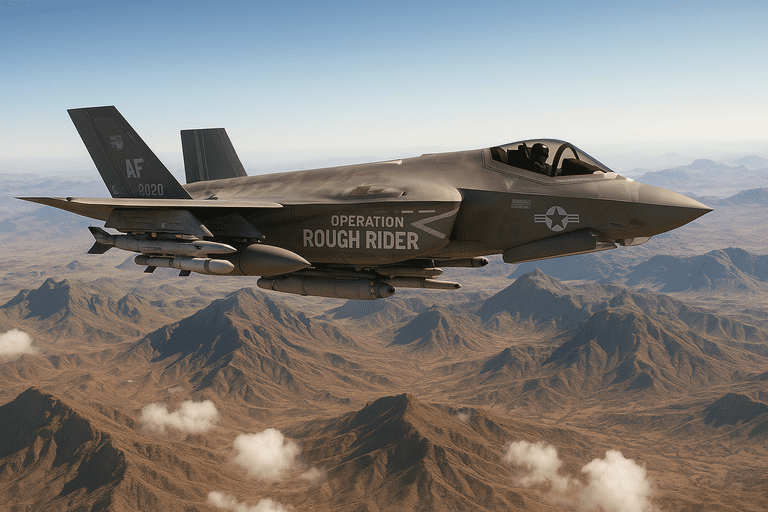In March 2025, the United States initiated Operation Rough Rider, a comprehensive campaign of air and naval strikes targeting Houthi positions in Yemen. This operation represents the most extensive U.S. military engagement in the Middle East during President Donald Trump’s second term. The primary objectives include neutralizing radar systems, air defenses, and missile launch sites utilized by the Houthis to disrupt international shipping in the Red Sea and Gulf of Aden. (en.wikipedia.org)
The Houthis began targeting international shipping in October 2023, following Israel’s invasion of the Gaza Strip in response to the October 7 Hamas attacks. In response, the U.S. military has escalated its operations to safeguard maritime routes and regional stability. (en.wikipedia.org)
The operational scope expanded on April 30, 2025, when the United Kingdom joined the United States in conducting coordinated strikes on Houthi targets. British Royal Air Force Typhoon FGR4 fighter jets executed precision strikes on facilities identified as drone manufacturing centers used in naval attacks. The British Ministry of Defense emphasized meticulous planning to minimize civilian casualties and collateral damage. (en.wikipedia.org)
The Houthis have reported significant casualties and infrastructure damage resulting from these operations. They claim that strikes have targeted residential areas, power stations, and ports, leading to civilian deaths and injuries. The U.S. military acknowledges reports of civilian casualties but maintains that all targets are selected based on intelligence indicating their use for military purposes. (en.wikipedia.org)
The deployment of B-2 Spirit stealth bombers to Diego Garcia in late March 2025 underscores the strategic emphasis placed on this operation. This marks the first significant deployment of B-2s to Diego Garcia since 2020, highlighting the importance of the mission. The bombers have been utilized to strike hardened underground weapons storage facilities, demonstrating the capability to neutralize fortified targets. (en.wikipedia.org)
President Trump has articulated that any future Houthi attacks will be interpreted as direct actions by Iran, with corresponding consequences. This stance reflects a broader strategy to counter Iranian influence in the region and deter support for proxy groups. (en.wikipedia.org)
The operational tempo and resource allocation for Operation Rough Rider are substantial. The campaign involves extensive coordination between air and naval assets, intelligence gathering, and logistical support. The financial implications are significant, encompassing munitions expenditure, equipment maintenance, and personnel deployment. (en.wikipedia.org)
The complexity of the mission is further compounded by the need to balance military objectives with humanitarian considerations. Efforts to minimize civilian casualties require precise intelligence and targeting, which can be resource-intensive and time-consuming. The potential for collateral damage remains a persistent challenge, necessitating ongoing assessment and adaptation of operational tactics. (en.wikipedia.org)
The international response to the U.S. and U.K. operations in Yemen has been mixed. Some allies express support for actions aimed at ensuring maritime security and regional stability. Others raise concerns about the escalation of conflict and the humanitarian impact on the Yemeni population. The operations have also prompted discussions about the effectiveness of military interventions in achieving long-term strategic goals. (en.wikipedia.org)
Domestically, the operations have sparked debates regarding the allocation of military resources and the prioritization of engagements. Questions arise about the sustainability of prolonged operations and the potential strain on military readiness for other contingencies. The financial costs are scrutinized in the context of broader defense spending and budgetary constraints. (en.wikipedia.org)
The operational environment in Yemen is characterized by a complex interplay of local, regional, and international actors. The Houthis’ capabilities and tactics continue to evolve, requiring adaptive strategies and continuous intelligence efforts. The potential for unintended escalation with other regional powers adds another layer of complexity to the mission. (en.wikipedia.org)
In summary, Operation Rough Rider exemplifies the multifaceted nature of modern military engagements. The campaign involves significant resource commitments, strategic coordination with allies, and careful consideration of humanitarian impacts. The ongoing operations necessitate continuous evaluation of objectives, tactics, and resource allocation to align with broader strategic goals. (en.wikipedia.org)
The situation remains dynamic, with operational outcomes and strategic implications unfolding over time. The commitment to achieving mission objectives persists, with ongoing assessments to inform future actions and policy decisions. (en.wikipedia.org)
—
Ryan Mitchell reports on military funding, defense policy, and veteran support systems. He is a graduate of The Citadel and served as a civilian analyst for the Department of Defense before entering journalism. His reporting draws on firsthand knowledge of procurement systems, veterans’ programs, and the long-term cost of military readiness.



